Barinaale Dube: Preserving Black History in The Bull Run Mountains
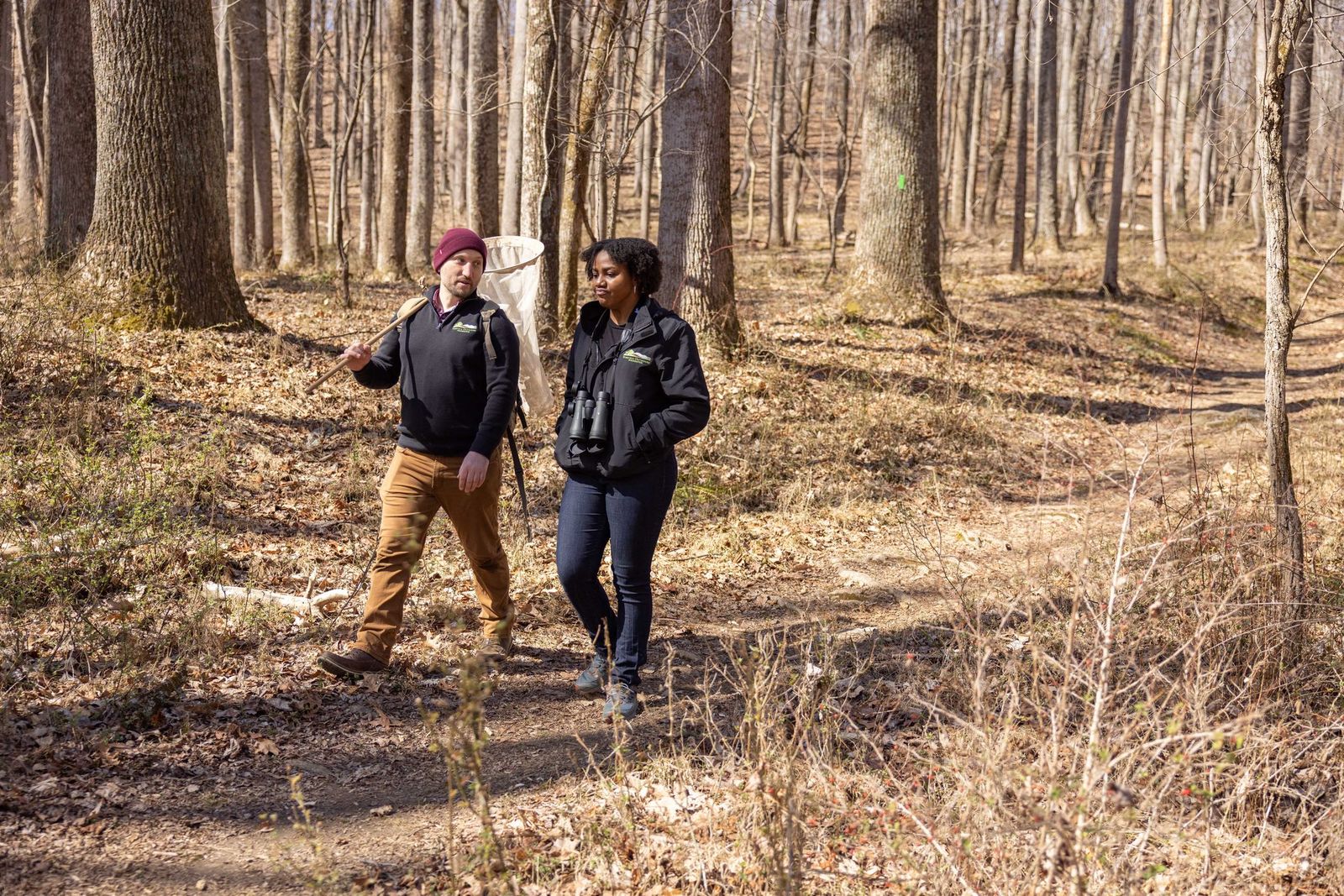
Barinaale Dube: Preserving Black History in The Bull Run Mountains
Written by Heidi Baumstark
Land has the power to connect – connecting people to nature and to past generations who once lived there. The Bull Run Mountains Natural Area Preserve — a 2,486-acre property – is a local sanctuary of natural and cultural heritage that straddles Virginia’s Prince William and Fauquier counties.
The Virginia Outdoors Foundation (VOF) — created in 1966 by the Virginia General Assembly – owns and manages the majority of the Preserve, protecting the mountains’ heritage, its natural resources, conducting research, and sharing it with the public through managed access points. That’s why the Preserve is referred to as a living laboratory and open-air museum. VOF is Virginia’s leader in land conservation, protecting over 850,000 acres in 111 counties and cities. However, long before this property on the Bull Run Mountains became a VOF-designated Natural Area Preserve in 2002, evidence shows that people settled there.
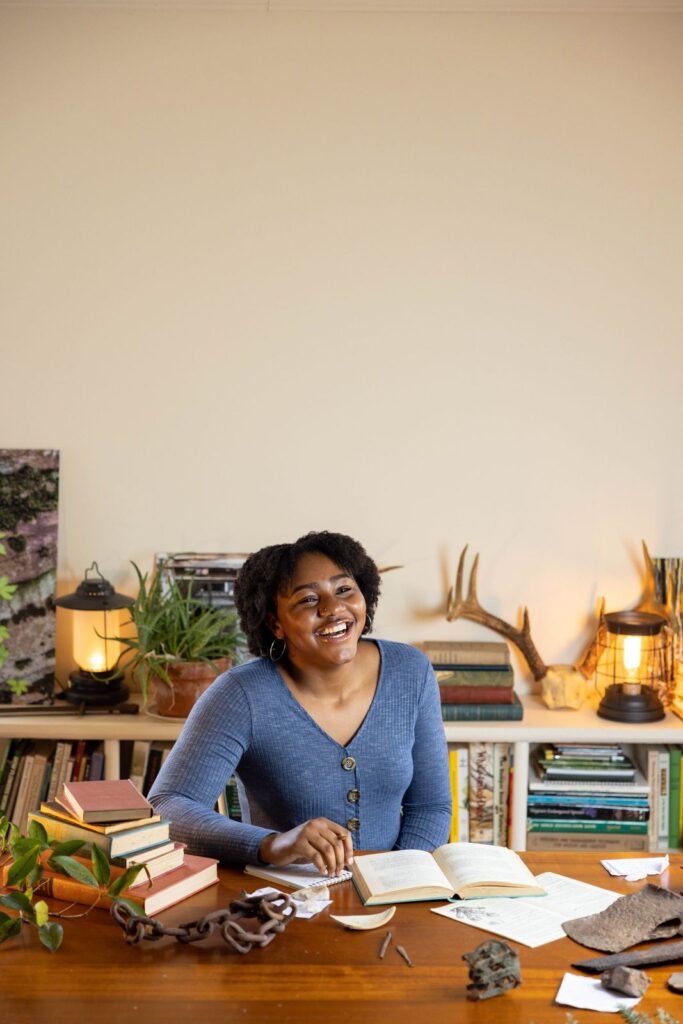
To reveal the Preserve’s past life, VOF has developed a cultural history research program called “Making History Our-Story” that sheds light on the diverse population who lived there from the 1820s through the 1960s. Barinaale Dube, a cultural history interpreter for VOF, is researching a Black community who purchased land tracts there from the 1850s through the 1920s.
Through her research, Dube uncovers remnants of old homesteads and industries and shares those stories during free guided hikes. Videos and articles about her discoveries are also posted on VOF’s website and social media outlets. On her hikes, participants will see cemeteries, quarry trenches, remnants of stone foundations, and former dwellings.
To piece together stories of this, until recently, unresearched community, Dube sifts through slave schedules, receipts, Civil War soldier registers, census documents and deeds, and images from aerial photos, and collects oral histories from neighbors and descendants. She conducts her research at the Afro-American Historical Association of Fauquier County in The Plains. Karen White, the association’s co-founder and director, says, “We helped Barinaale get started with her research and have been a documentation source. Our repository has been beneficial to her work.”
Preserve Manager Joe Villari, who came to VOF in 2016 after working at the Smithsonian Museum of Natural History, hired Dube in June 2020 as VOF’s inaugural cultural history fellow. By the end of 2020, she became their cultural history interpreter. “Barinaale has been a major boost to our developing history program — and through her research and hikes – connecting the community to learn about this area’s past,” Villari says.
The Preserve is divided into three sections: North Section, Jackson Hollow, and South Section. The South Section is where Dube leads hikes, and it consists of 800 acres with seven miles of trails open to the public Friday through Sunday. The North Section and Jackson Hollow each have different focuses, research areas, and varying accessibilities.
On the Trail
On a hike in February, Dube led a group of about 20 hikers and highlighted several locations of cultural significance: Chapman Cemetery, a quarry trench, and sites of significance to three Black families: the Coles, the Corums, and the Robinsons. VOF’s Preserve Specialist Taryn Bromser-Kloeden joined the hike, adding her expertise along the way.
- Chapman Cemetery contains tombstones of the Chapmans, the family who owned and built the 18th century Chapman-Beverley Mill. This mill had far-reaching importance as an economic engine for the local community. George Chapman is buried in the Chapman Cemetery under a tall obelisk made of artisan stone that was brought in from D.C. which reveals the economic status of this family. His obelisk includes this inscription: “George Chapman by His Wife” with no dates or additional inscription. The phrase “By His Wife” indicates his wife, Susan, commissioned the monument for his gravesite. Susan’s tombstone reads: “Susan Pearson, a consort of George Chapman born May 20, 1780, died April 14, 1856.” George (born in 1769 and died 1829) was married to his first cousin, Susanna Pearson Alexander in 1799 and they had 12 children. Other tombstones have surnames of Pearson, Williams, and Swann. The stone wall around the cemetery is thought to be of local stone quarried from this mountain range.
- A long, deep, and narrow quarry trench is the next stop. It is presumed that rocks were pulled out by hand and pushed down the mountain or transported by wagon. When the Manassas Gap Railroad came through Thoroughfare Gap in 1852, the rock may have been placed on the train for market purposes. There is evidence of multiple rock quarries along Catlett’s Branch stream in the Preserve’s South Section. Were the workers advertising the stone for sale? If so, in local newspapers or by word-of-mouth? Was the stone used to build local houses and structures? With lumber production as another industry on the mountain, the Gaines’ lumber mill was in the North Section of the Preserve. “Some of our target mountain historical figures worked at this mill,” Villari notes.
- The third stop located near Catlett’s Branch, is the property of Hampton Cole who was born free in the 1830s. He lived in a house that he built near this stream, which no longer stands. “There’s a stone foundation of a house nearby which may be Cole’s. There’s also stone fencing,” Dube says. It is presumed that his job was quarrying rock. In 1856, Cole purchased 16 acres from William Roach, a white slave owner. During the mid-1800s, it’s believed that the Underground Railroad passed through this mountain gap.
During the Civil War, Cole was working as a laborer for the Confederacy and was stationed in Alexandria, Virginia, working at the docks. After the war ended in 1865, his wife and son contracted typhoid fever, but Cole was able to bring them to Manassas for treatment. “This speaks of his economic position to be able to afford medical care,” Dube points out. However, tragically, his wife and son died within three days of each other.
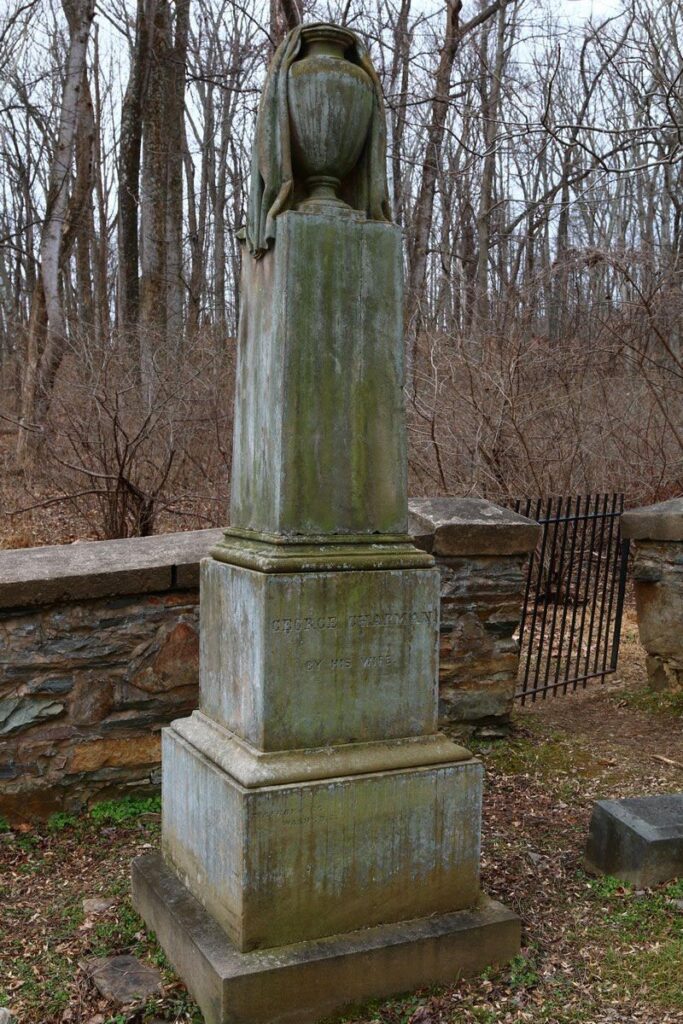
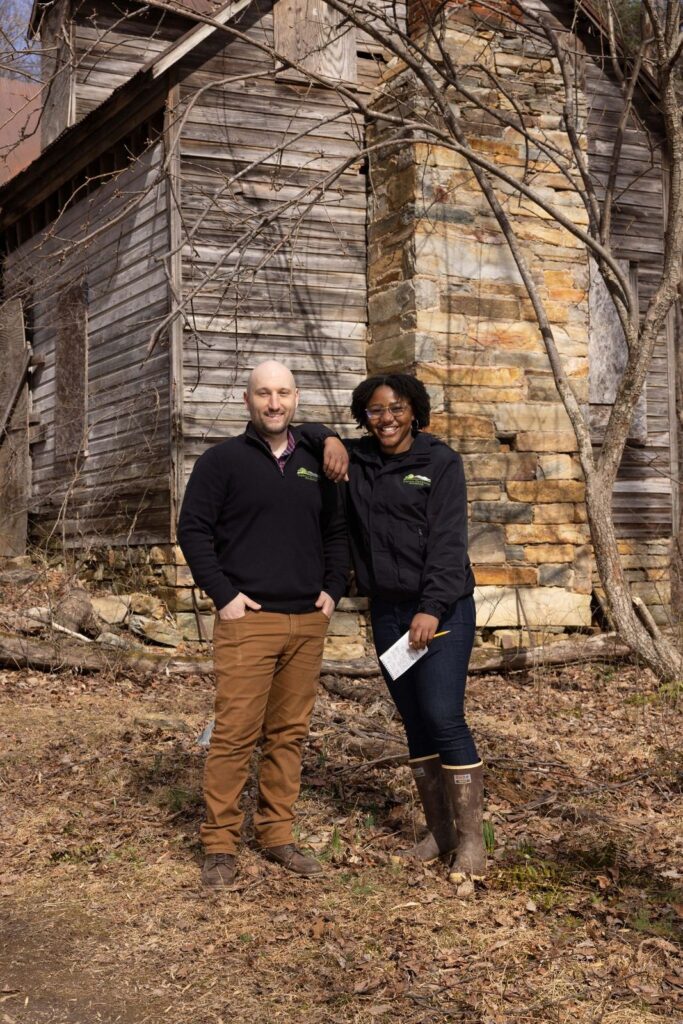
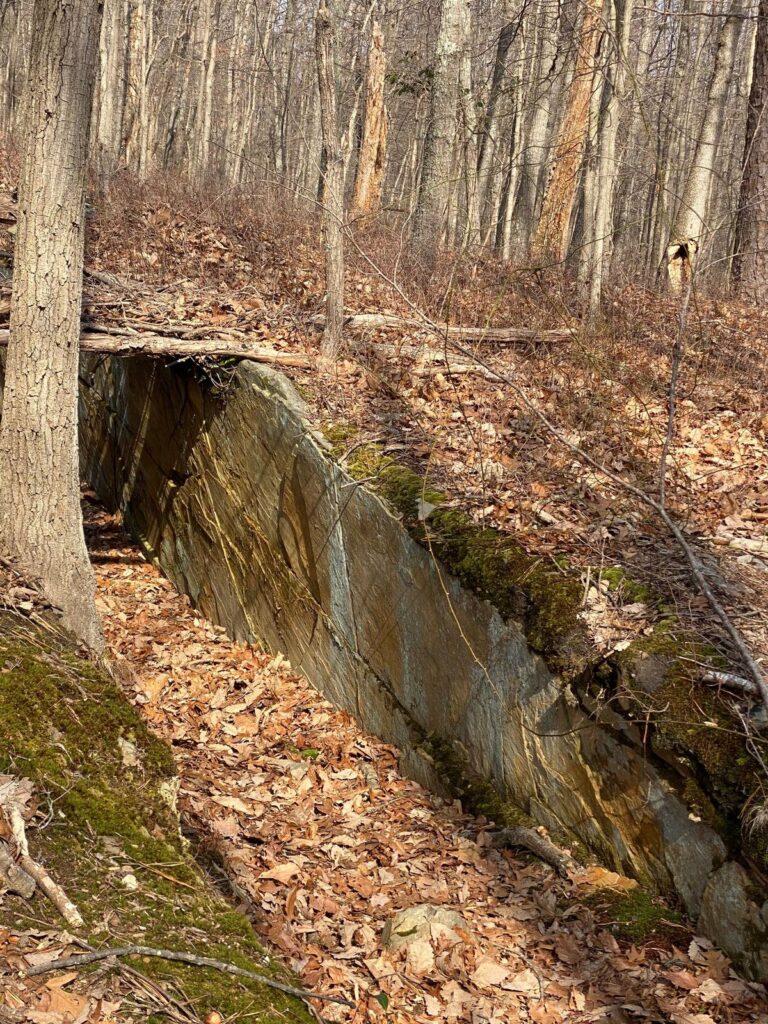
More tragedy struck when Cole returned to his house on Bull Run Mountain and found a white squatter living inside. As a Black man, “people didn’t believe it was really his property,” Dube shares. Ultimately, he lost his house and property in 1877 since he was unable to pay the balance. He later remarried and died in 1904.
Patrick O’Neill, professional archaeologist and historian and president of the NOVA Chapter of the Archaeological Society of Virginia, believes that Cole’s 16 acres was the first of ten tracts of land held by Black landowners in the South Section of the Preserve. And his land was the first that would be quarried between the 1850s and the 1920s.
- Moving on, Dube leads us to Beverly Corum’s house (known as the Lower Corum House) near Catlett’s Branch. One end of the house has a stone foundation and stone fireplace; it’s presumed that the stone came from this mountain. O’Neill’s research indicates the oldest part of the Lower Corum house is a log section that could date to the 1740s. A newer section was added circa 1910. “It’s thought the house was somewhere else on the mountain, was dismantled, and then moved here,” Dube says.
Bromser-Kloeden points out a pear tree and bushes of wineberries near the old wooden house. “We believe they had a small garden despite the less-than-ideal soil conditions,” she adds.
Corum was born on the mountain and worked at nearby Aldie Mill in Loudoun County. He served in World War I and all six of his sons served in World War II. He also had two daughters. In the 1920s, Corum bought ten acres. His wife was Mary Jane Robinson, the daughter of Moses Robinson, who lived nearby. Dube pointed out the rarity that Moses was educated through high school.
- The final stop is the Corum-Robinson Cemetery, which is presumed to hold the graves of the Corum and Robinson families. On top of a high ridge about fifteen graves are marked by field stones tilting up from the forest floor. O’Neill identified these unmarked headstones and footstones with small white flags for research purposes. This final stop shows the stark difference between the Chapman Cemetery with engraved tombstones enclosed by stone walls and the humble Corum-Robinson Cemetery with stones barely resembling gravesites. The absence of any carvings on these stones speaks volumes.
Dube ends the hike posing this question: “What kind of ancestors do we want to be?”
Tina Boyd of Haymarket came on the hike with her husband, Lance, at the suggestion of their neighbors. “We live at the base of Bull Run Mountain and are blessed with the beauty of it,” Boyd shares. “It’s intriguing to understand who lived here and to hear their stories. As we walked, I imagined their journey. I was most surprised by the cemeteries deep in the mountain woods.”
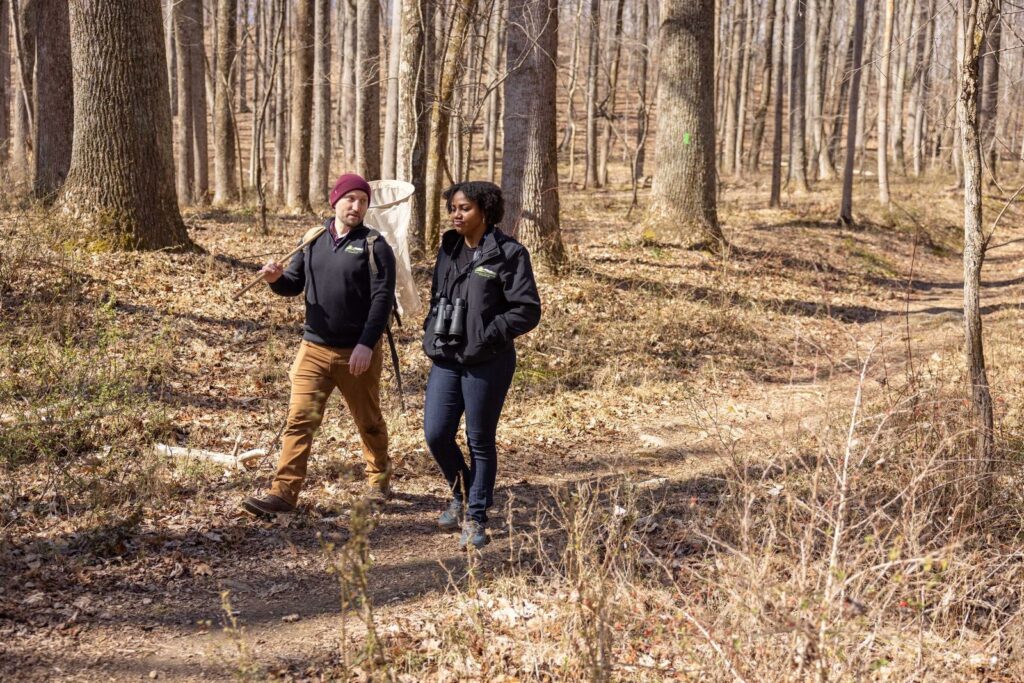
Connecting Community
Villari says, “History is not just about generals and kings; it’s about the common experience. We’re trying to keep the hikes original and organic, connect people to a sense of place, increase mindfulness, and socio-economic awareness. Our future plans include incorporating interpretive signage at various sites.”
Much to Villari’s surprise and enjoyment, family members of these long-gone mountaineers have joined in on several hikes. “I’m in awe anytime I’m able to walk with the descendants of those who lived here. There is just something powerful in those moments,” Villari shares.
Dube concludes, “Community is essential in all we do — connecting history to the community.” That’s the power of land. ML
VOF’s Bull Run Mountains Natural Area Preserve is located at 17502 Beverley Mill Drive in Broad Run, Virginia. For more information, call 571-438-8957 or visit vof.org. For videos and posts of Dube out in the field sharing her discoveries, check out the Preserve’s Facebook and Instagram pages, which also list dates of future hikes.
This article first appeared in the April 2022 Issue.


